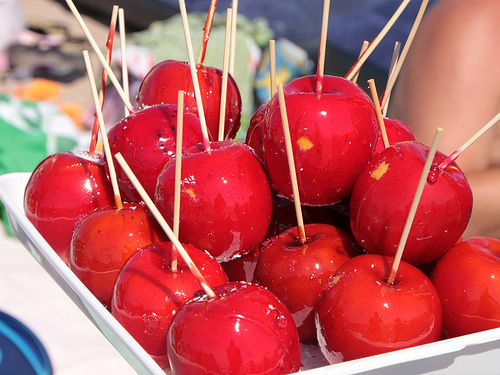Although candy apples are evolving into a tradition, they are well suited anytime!
- A candy apple is a confectionery item consisting of an apple, that has been dipped in a hard sugar or toffee mixture to coat it; and includes a wooden or plastic stick pushed into the apple, which is used to hold it.
- ‘Candy apples’ are also known as ‘candied apples’, ‘toffee apples’, ‘lollipop apples’, and ‘taffy apples’.
- Candy apples are most popularly eaten as a snack during autumn months when apples are at their peak season, especially during times of celebration, or at carnivals and fairs.
- Typically, the hard coating of a candy apple is a red colour, likely due to tradition, as well as the appealing and striking nature of the colour.
- The sugary coating of candy apples is typically made from sugar, corn syrup, food colouring, and water, although the ingredients may vary, and they are sometimes flavoured with cinnamon.
 Candy Apples
Candy Apples
Image courtesy of Emilian Vicol/Flickr
- The candy apple invention is often attributed to candy maker William Kolb of New Jersey, in the United States, who is said to have placed toffee-covered apples in a display window in 1908, and he promptly sold them for five cents per apple.
- Candy apples are commonly confused with caramel apples, which are notably different in that the latter’s coating is generally made of soft caramel rather than hard toffee.
- The oldest known written recipe for a candy apple originated in 1919, found in the cookbook “Rigby’s Reliable Candy Teacher” and it was referred to as an ‘apple on a stick’.
- Apple cultivars of particular tartness, like Granny Smiths, are optimal for candy apples, as the flavour compliments the sweetness, and these apples usually have a firm texture.
- Climates with high humidity render candy apples as somewhat impractical, as excessive levels of humidity cause the hard sugar coating to become soft and runny.
Bibliography:
Candy Apple, 2016, Wikipedia, https://en.wikipedia.org/wiki/Candy_apple
Nudi E, Food History: Candied Apples, 2014, Erinnudi.com, http://www.erinnudi.com/2014/09/25/food-history-candied-apples/
Olver L, Food Timeline FAQs: Candy, 2015, Food Timeline, http://www.foodtimeline.org/foodcandy.html#candiedapples





